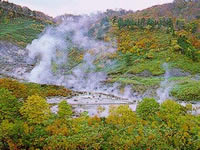Hokutolite, Tamagawa Onsen, Obuki Fountainhead, and Bedrock Baths 
Hokutolite: A National Natural Monument
Hokutolite, called hokutoseki in Japanese, is a mildly radioactive mineral composed of barium and lead sulfate with lead and radium. Hokuto is the Japanese name for the Beitou hot spring region of Taiwan where it was discovered in 1906. In 1911, it was found that the hokutolite discovered in Taiwan was actually the same mineral as one previously discovered at Semboku’s Tamagawa Onsen hot spring (then called Shibukuro Onsen) in 1898.
At Tamagawa Onsen, hokutolite forms when hot water from Obuki, the spring’s fountainhead, begins to cool as it flows down the Yugawa River. The hot spring water contains barium, lead, and strontium ions, which begin to crystalize as the temperature of the water drops.
The crystalized ions form a crust on the stone surface of the riverbed, which grows at a rate of one millimeter every ten years. A cross-section of the crust reveals a pattern of dark-brown and white streaks. The pattern of the streaks depends on the ratio of barium sulfate to lead sulfate as well as on differences in iron oxide content. It is the radium content that makes hokutolite slightly radioactive.
Hokutolite is rare, only found in the Beitou region of Taiwan and Tamagawa Onsen in Japan. The mineral is protected in both countries, and in Japan is a designated Special Natural Monument and therefore illegal to collect or remove.
Tamagawa Onsen, Obuki Fountainhead, and Bedrock Baths

Every minute approximately 8,400 liters of water gush out of Tamagawa Onsen’s hot springs, the highest output of any hot spring in Japan. The hot spring’s main component is hydrochloric acid, making it Japan’s most acidic, with a pH of 1.2. This type of hot spring can only be found in areas with high levels of volcanic activity, as the hydrochloric acid comes from volcanic gases. Even in a country with as much volcanic activity as Japan, the high level of acidity of Tamagawa Onsen’s water is a natural wonder.
The water is a piping-hot 98°C when it leaves Obuki, the spring’s fountainhead. It then forms a river of hot water 3 meters wide. The river, Obuki, and fumaroles emitting steam can all be seen from the Tamagawa Onsen Hot Spring Nature Research Path, a one-kilometer path that winds through the grounds of the hot spring area and takes roughly 30 minutes to complete. The path also passes bedrock heated by geothermal energy where visitors can enjoy stone baths, called ganban-yoku in Japanese. After spreading a mat on the hot bedrock, guests cover themselves with a blanket and allow the soothing warmth to relax their muscles.
Tamagawa Onsen was first discovered in 1681 and opened as a center for toji, hot-spring healing, in 1884. The springs became a major hot spring health resort after 1932.
Nearby Shin-Tamagawa Onsen, opened in 1998, also provides accommodation and bathing facilities. Both share the same hot spring water source and are sought out for the therapeutic qualities said to come from the water’s high acid content and radium.
Though many consider the high acid content to be beneficial, it can cause a tingling sensation as one bathes. While the full acidity water is perfectly safe and the main draw for many visitors, both resorts provide a variety of bathing options with lower temperatures and acidity. The purported health benefits of Tamagawa Onsen’s water and its bedrock bathing culture draw people from all over Japan to rest and recuperate.
- Location
- Shibukurosawa, Tamagawa, Tazawako
- Contact Info
- Tamagawa Onsen: 0187-58-3000 / Shin-Tamagawa Onsen: 0187-58-3100
- Access Information
- Regular bus from JR Tazawako Station (For Hachimantai Summit, or for Tamagawa Hot Springs)
Akita Airport Liner (Kakunodate/Tazawako/Tamagawa Hot Springs Course)
- Access
- Sightseeing Spots
- Choose from areas
- Hachimantai/Tamagawa
- Nyutou
- Tazawako Plateau/Mizusawa/Komagatake
- Tazawako
- Dakigaeri/Jindai/Shiraiwa
- Nishiki
- Kakunodate
- Seasonal Recomendations
- Lists by Season
- Campgrounds
- Products
- Other
